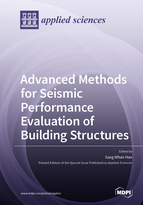Advanced Methods for Seismic Performance Evaluation of Building Structures
A special issue of Applied Sciences (ISSN 2076-3417). This special issue belongs to the section "Civil Engineering".
Deadline for manuscript submissions: closed (31 March 2020) | Viewed by 36937
Special Issue Editor
Interests: developing seismic design and performance evaluation methodology; large scale experiment of building components
Special Issues, Collections and Topics in MDPI journals
Special Issue Information
Dear Colleagues,
Earthquakes are one of the most dangerous natural events inflicting damage and collapse of buildings and infrastructures. In particular, 10,000 people lose their lives on average from earthquakes each year. Not only do earthquakes come in different sizes, they could also occur anywhere in the globe. The demand to reduce the risk associated with earthquakes has been growing every year and leading to a greater research focus on seismic design and seismic performance evaluation. Recently, the performance-based seismic engineering approach has been adopted in the earthquake engineering community. In this approach, multiple seismic performance objectives are specified explicitly, which are defined with combinations of seismic hazard levels and structural and non-structural performance levels, unlike conventional prescriptive design approaches. Critical components of performance-based seismic design and evaluation procedures include state-of-art technologies relating seismic hazard analyses, robust numerical simulation frameworks, and sophisticated performance-based seismic design and assessment methodologies. Although major technologies have been developed, many challenging obstacles have to be solved to make them implemented in code provisions. The Special Issue of the journal Applied Sciences on “Advanced Methods for Seismic Performance Evaluation of Building Structures” aims to cover recent advances in the development of major components of seismic performance evaluation and design.
Prof. Sang Whan Han
Guest Editor
Manuscript Submission Information
Manuscripts should be submitted online at www.mdpi.com by registering and logging in to this website. Once you are registered, click here to go to the submission form. Manuscripts can be submitted until the deadline. All submissions that pass pre-check are peer-reviewed. Accepted papers will be published continuously in the journal (as soon as accepted) and will be listed together on the special issue website. Research articles, review articles as well as short communications are invited. For planned papers, a title and short abstract (about 100 words) can be sent to the Editorial Office for announcement on this website.
Submitted manuscripts should not have been published previously, nor be under consideration for publication elsewhere (except conference proceedings papers). All manuscripts are thoroughly refereed through a single-blind peer-review process. A guide for authors and other relevant information for submission of manuscripts is available on the Instructions for Authors page. Applied Sciences is an international peer-reviewed open access semimonthly journal published by MDPI.
Please visit the Instructions for Authors page before submitting a manuscript. The Article Processing Charge (APC) for publication in this open access journal is 2400 CHF (Swiss Francs). Submitted papers should be well formatted and use good English. Authors may use MDPI's English editing service prior to publication or during author revisions.
Keywords
- Numerical models
- Model parameters
- Analysis algorithm
- Seismic performance evaluation
- Seismic risk
- Seismic hazards
- Seismic force resisting systems
- Energy dissipaters
- Seismic design and mitigation
- Assessment method
- Ground motions
- Nonlinear response






